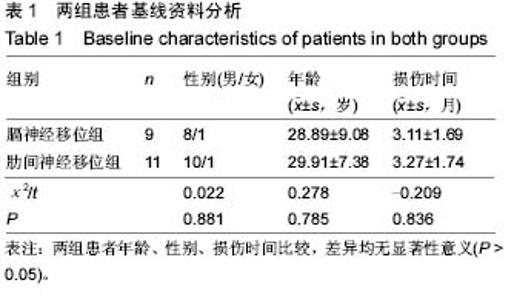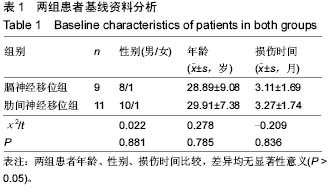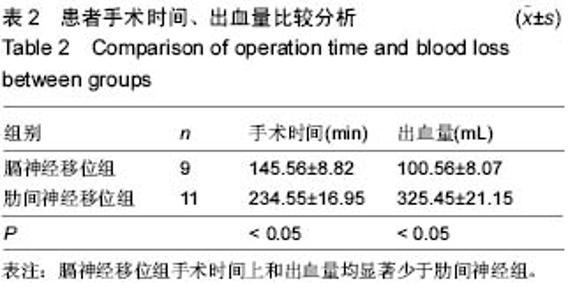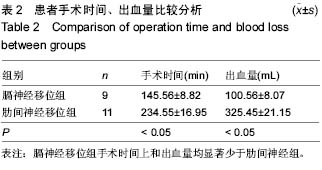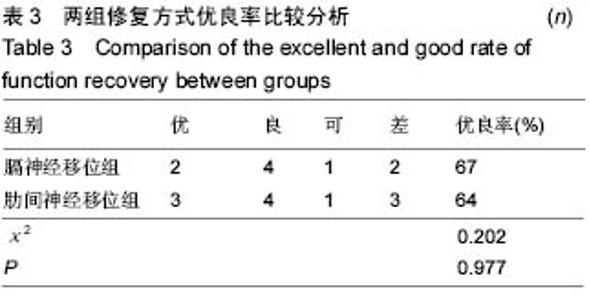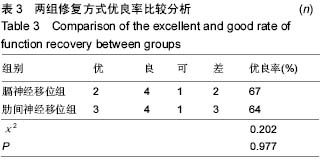| [1] Midha R. Epidemiology of brachial plexus injuries in multitrauma population. Neurosurg.1997;40(6): 1182-1189.[2] Meguiness CN,Kay SP.The prespinal route in contralateral C7nerve root transfer for brachial plexus avulsion injuries.J Hand surg. 2002; 27(2): 159-160.[3] Bertelli JA, Ghizoni MF. Brachial plexus avulsion injury repairs with nerve transfem and nerve grafts directly implanted into the spinal cord yield partial recovery of shoulder and elbow movements. Neurosurgery. 2003; 52(6):1385-1390.[4] 顾玉东,张高盂,陈德松,等.健侧颈神经根合并多组神经移位治疗臂丛根性撕脱伤[J].中华显微外科杂志, 1991, 14(3):129-132.[5] 孙贵新,范存义,顾玉东.臂丛根性撕脱伤后的治疗与功能重建[J].中国临床康复,2006,10(38):139-142.[6] Seddon HJ. Nerve grafting.J Bone Joint Surg.1963; 45B:447-461.[7] Gu YD, Wu MM, Zhen YL, et al. Phrenic nerve transfer for brachial plexus neurotization. Microsurgery.1989; 10:287-289.[8] Freilinger G, Holle J, Sulzgruber SC. Distribution of motor and sensory fibers in the intercostal nerves. Significance in reconstructive surgery.Plast Reconstr Surg.1978; 62:240-244.[9] Rohde RS, Wolfe SW. Nerve Transfers for Adult Traumatic Brachial Plexus Palsy(Brachial Plexus Nerve Transfer). HSSJ.2007; 3: 77-82.[10] Allieu Y,Chanmas M,Picot MC.Paralysis of the brachial plexus caused by supracalvicular injuries in the adult Long-term comparative results of nerve grafts and transrers.Rev Chir Orthop Reparatrice Appar Mot.1997; 83:5-59.[11] Chuang DC, Yeh MC, Wei FC. Intercostal nerve transfer of the musculocutaneous nerve in avulsed brachial plexus injuries: evaluation of 66 patients.J Hand Surg. 1992; 17A: 822-828.[12] Samardzic M. Nerve transfer in brachial plexus traction injuries. J Neurosurg. 1992;76(3):191-192.[13] 马建军,张高孟,徐建光,等.治疗臂丛损伤移位神经的组织化学研究[J].中华手外科杂志,1997,13(4):235-237.[14] 张丽银,顾玉东.膈神经移位术后肺功能随访观察[J].中华手外科杂志,1994,10(1):10-11.[15] 张波,于彦铮.肌皮神经功能柬在臂丛内各段的定位解剖研究[J].解剖学报,1992,23(1):7-9.[16] 董震,成效敏,顾玉东.膈神经移位上干前股的疗效分析[J].中华手外科杂志,2007,23(2):85-86.[17] Samii A,Carvalho GA,Samii M.Brachial plexus injury:factors affecting functional outcome in pinal accessory nerve transfer for the restoration of albow flexion. Neurosurg.2003;98(2):307-312.[18] 官士兵,陈德松,顾玉东.副神经移位治疗臂丛神经损伤的进展[J].中华创伤骨科杂志,2004,6(2):213-216.[19] 陈正永,沈丽英,马建军,等.膈神经副神经肌电图检查对提高臂丛神经根性损伤诊断符合率的机制和意义[J].中华手外科杂志,1999,14(3):161-163.[20] 胡溱,董虎林,韦加宁,等.肋间神经移位治疗全臂丛根性撕脱伤两种术式的比较[J]. 中华手外科杂志,2000,16(1): 34-36.[21] 孙贵新,顾玉东,虞聪,等.二期多组神经移位治疗臂丛神经根性撕脱伤的临床应用和疗效[J].中国修复重建外科杂志,2005,19(6):450-452.[22] Chuang DC,Lee GW,Hashem F,et al.Restoration of shoulder abduction bynerve transfer in avulsed brachial plexus injury:evaluation of 99 patients with various nervetransfers.PlastReconstruction Surg.1995; 96(1):122-128 |
